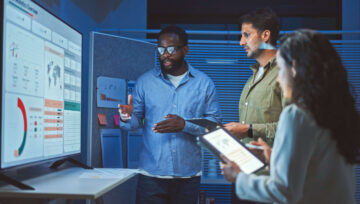18 Minute Read
Table of Contents
Introduction
To keep your team aligned around the common cause of creating an excellent customer experience, it’s extremely valuable to set effective customer service goals. Today we’ll dive into the process of setting goals for customer service teams, and explain how to do so in a way that sticks. Read on for a blueprint for improving the performance of your entire team and stay tuned to the end for some of the most effective customer service goals to try in 2025!
Key takeaways
- Benefits of customer service goals: By setting effective goals for customer service, you can provide consistent service, simplify the management process, and strengthen customer satisfaction.
- Setting SMART customer service goals: For a goal to be effective at creating real change that improves overall performance and increases customer satisfaction, the goal must be “SMART” (Specific, Measurable, Achievable, Relevant, and Timed).
- Common customer service goals: Some of the most effective customer service goals include decreasing response times, improving customer satisfaction, increasing customer loyalty, and implementing helpful tools like omnichannel customer service and self-service options.
Why you need to set customer service goals
Developing a cohesive vision for your company is the first step on the road to success, and setting clear and actionable customer service goals is one of the most powerful ways you can help your customer service team to catch that vision.
Consistency
By setting customer service goals, you ensure that your team has an understanding of the company’s plans and give them a chance to buy in. With the whole team aligned around the same goals, your customers will get a higher and more consistent quality of service. Good customer service goals also provide consistency across teams and departments, providing a throughline of related objectives instead of a variety of siloed and disjointed operations.
Simplicity of management
When customer service goals are measurable, reasonable, and well-communicated, it makes it much easier for supervisors to look at team and individual performance with an objective eye. It also allows agents to better understand what success looks like and which metrics they are shooting for.
Customer satisfaction
Customer service goals should be specifically formulated to provide a better customer experience. A well-set goal that is adequately communicated to your team will vastly improve your team’s performance, making it massively more likely that your customers will have an extraordinary experience with your brand.
How to set goals to improve your customer service

A goal is more than simply stating that you want to do something. It’s a statement of clear intention and an understanding of what it will take to reach that objective, and the declaration of a structured plan to get there. A customer service goal should be no different.
One of the most effective and commonly used methods of writing an effective goal is the “SMART” goal method, and customer service departments often use this method to improve their customer experience.
To formulate your customer service goals according to the SMART method, each goal should be:
- Specific
- Measurable
- Achievable
- Relevant
- Timed
Specific
A common problem people encounter when setting goals for customer service is being too vague, which makes it difficult to know what success actually looks like. To avoid this pitfall, you should be more specific in your goals, delineating the precise level of change you hope to affect and when you hope to reach that level.
Wrong: "Increase customer satisfaction scores."
This is much too vague to have any real meaning. Does any amount of increased satisfaction count as success? When do we need to increase it? What’s good enough? The ambiguity of this goal runs the risk of each individual on your team interpreting it in their own way, leaving with the general understanding that customer satisfaction needs to increase, but nothing to shoot for, so no real alignment is reached.
Right: "Increase quarterly average customer satisfaction score of Q3 by 30% over Q2."
This goal specifies that the team needs to achieve an average customer satisfaction score in Q3 that is 30% higher than it was in Q2. It doesn’t leave the achievement up to interpretation, so the entire team knows what successfully reaching this goal would look like.
Measurable
Going hand-in-hand with “Specific,” It’s important to set customer service goals in a way that you can actually objectively measure. The lack of quantitative benchmarks to shoot for leaves the goal up to interpretation, which creates a moving target that is hard to conceptualize. When a goal isn’t measurable, your team will either disregard the goal because success seems out of their hands, or give up on it because it seems overblown.
Wrong: "Reduce average call handling times."
In this goal, we don’t have an objective measurement to define success. By how much do call handling times need to be reduced? When does the goal need to be reached? Over what frame of time will the average be measured?
Right: "Reduce the monthly average call handling time by 15% by January of next year."
This time, we know the amount that the average call handling times need to reduce, how often the average is measured, and when we need to reach the goal.
Achievable
For a goal to be properly motivating, it has to be realistically achievable. When you set goals for customer service teams they should be challenging enough that the team needs to push a little, but not so far challenging that the goal doesn’t seem possible. When you set an unreachable goal, you are effectively setting your team up for an unnecessary failure, because no matter how hard they try, they won’t reach that particular definition of success. Unrealistic customer service goals are bad for morale for a variety of reasons, including:
- Lack of respect: By giving them unachievable goals, you send the message to your customer service team that you don’t respect their contributions or frontline experience. By definition, these unachievable goals inherently label everything your team does as “Failure”. This kind of culture is a breeding ground for high turnover.
- Ignores small gains: With the benchmark of success placed at such a high level, everyone will have their eyes on the unachievable goal. In the meantime, the team might be making smaller achievements worthy of praise, but these smaller successes go unrecognized, and therefore won’t be reinforced long-term.
- Lack of control: The expectation of achieving “perfection” ignores the reality of customer service, which often involves variables outside anyone’s control (difficult customers, emergency situations, technical difficulties, etc.). Though a good team might overcome many of these challenges on the way to a goal, there needs to be some wiggle room to account for external problems.
- Creates defeatism: Finally, when success (as defined by a goal) simply isn’t possible, it removes the drive to succeed. When a team is consistently shown that they can’t reach goals, they begin to expect failure and stop trying to achieve success.
Wrong: "Reach 100% average customer satisfaction score by the end of the month."
Go shopping online and look at the reviews, and you’ll quickly see that 100% satisfaction is extremely rare, and often only seen on products with very few reviews. Similarly, even with a perfect customer service team, you’re extremely unlikely to have 100% customer satisfaction at any point, especially with a large volume of customers calling in. Additionally, even if such a huge goal was attainable, the deadline of one month is far too soon to expect your team to reach it.
Right: "Increase average customer satisfaction score by 5% by the end of Q2."
By setting a customer service goal of a small, incremental increase over a reasonable timeline, you can motivate your team without overburdening them.
Relevant
A good goal for customer service teams should be relevant to their day-to-day duties. For a goal to motivate them, it needs to be something that they can actually affect in the course of carrying out their regular tasks. If a goal’s success isn’t tied to the actions of a customer service team, then it isn’t a customer service goal, and communicating the goal to the customer service team isn’t particularly necessary or motivating.
Wrong: "Replace CSM by the end of March."
While replacing the CSM will definitely affect the customer service team once the new CSM is implemented, their buy-in and efforts aren’t necessary to accomplish the task.
Right: "Train all customer service agents on new CSM by the end of April."
Each customer service agent will need to complete their training in order to effectively use the new CSM and provide better help to customers, so their direct action is required to achieve this goal.
Timed
Finally, a good customer service goal should be timed. Goals should have reasonable deadlines that inspire action. Larger goals should have small in-built checkpoints at regular intervals along the way and the time-frames involved should be adequately communicated to the team.
Wrong: "Increase first-call resolution rate by 15%."
This is a good goal to shoot for, but there’s no timeframe given. Without a timeframe or deadline, this goal has no urgency, and the team may forget about it.
Right: "Increase first-call resolution rate by 15% by the beginning of Q4."
Now the team knows not only where they’re going, but also when they need to get there. This allows the goal to stay top-of-mind and motivate higher performance.
Customer service goals examples

With an understanding of how to set effective goals, it’s a good idea to turn to some specific examples of goals that many companies could use to improve customer service. While these goals would be useful for a wide variety of companies, it’s important to consider your specific business aspirations and which of these goals would best support them.
In addition, as discussed above, consider your resources and team when deciding what is both attainable and useful for your customer service goals.
Decrease your response time
Setting a goal to improve your response time can make a huge impact on your customer service. Why? Because customers appreciate — and are growing to expect — speedy service. Take a look at the data:
- 80% of customers said they want quicker responses from companies.
- 60% of customers said that resolving their issues quickly was the most important part of good customer service.
- While the majority of customers expect a response on social media within a few hours or less, less than half of companies regularly provide this speed of response.
Of course, decreasing response time isn’t just about speed — it’s also about resolving customer issues efficiently. In fact, 36% of customers say that getting their “issue resolved in a single interaction” was the most important part of good customer service.
As a result, it’s important to place value not just on the speed of the answer, but also on more quantitative areas like accuracy of responses, empathy, and connection. After all, you don’t want to decrease your response time at the expense of the quality of your service.
When setting a customer service goal around response time, you may want to track metrics such as:
- Average Response Time (ART)
- First Response Time (FRT),
- Average Handle Time (AHT), or
- Average time in queue.
Decrease your response time by:
- Increasing your live chat or self-service options
- Expand agent scheduling/staffing during peak periods
- Improve agent training so calls take less time to handle (reduced AHT generally leads to quicker response times)
- Analyze metrics on when customers tend to use which channels and assign agent roles accordingly
Increase your self-service options and automation
One of the biggest trends for 2025 in customer service is self-service and automation — and for good reason! Not only is automation and AI becoming more effective and “intelligent,” but customers are becoming more accustomed to it, and in some cases, even favoring it over live agents. For example:
- 69% of customers say they’ll try to resolve their issue on their own first before contacting the company directly.
- 81% of customers say they want more self-service options available as less than a third of companies offer self-service options.
- 90% of customers say that an “immediate response” is important when they have a customer service question.
Increasing your team’s automation options can help you improve many aspects of customer service, so this is a good customer service goal to focus on that will be a lever for other goals, such as decreasing response time or improving customer satisfaction. As a more tactical goal, make sure that you have an outcome in mind that is measurable and specific.
When setting goals around self-service options or automation, you might want to track metrics like:
- Chatbot analytics
- Knowledge base pageviews
- Customer feedback (especially pop-up “Was this page helpful?” surveys and other on-page feedback)
- Live chat ticket volume and handle time
- Time saved on specific tasks after introducing automation
Increase your self-service options by:
- Working with an expert to design and implement AI or chatbot solutions.
- Using feedback from web pages or interactions to further improve your self-service options and responses.
Updating web pages to direct customers with simple questions to chatbots instead of live customer service
Improve your customer service experience!
An outsourced call center can be just the tool you need to reach your customer service goals Learn more about how we can help!
Improve customer satisfaction
One of the biggest overall goals for many customer service teams or companies is to improve customer satisfaction. And of course, this makes sense — satisfied customers are more loyal to your brand, making them more profitable for your business.
And, after all, the goal of customer service is to resolve customer issues in a satisfactory way and design customer experiences that will create happy, loyal customers. But how can you make this an effective goal for your company?
Remember the SMART goals discussed above: design a specific, measurable customer service goal to improve a key customer satisfaction metric — for example, CSAT or NPS. Then analyze your current data and/or customer feedback to find the areas where customers are most frequently unsatisfied, and aim to improve those.
For example, you might improve customer satisfaction by:
- Improving your First Contact Resolution (FCR) rate
- Reducing Average Hold Time or Average Time in Queue
- Expanding the number of available channels customers can contact you through
- Reducing your Customer Effort Score (CES)
- Increasing agent training to improve the quality of your service
Consistently gather customer feedback
Some goals for your customer service team may be more qualitative than quantitative — for example, consistently gathering customer feedback. While this is an essential tactical goal for customer service teams — particularly if you’re not already doing so — it can be a difficult one to measure.
However, you can still measure this goal and growth in this area. For example, you can measure:
- How much feedback you’re receiving
- A certain number of items to action or implement each quarter
- A certain amount of feedback to collect
- A new type of feedback to be gathered
For example, you might set a goal such as, “Collect 120 customer feedback responses and analyze them to find the most common themes. Implement 1 change by the end of Q2 based on the most common theme.”
This goal keeps customer feedback at the forefront of your team’s focus, and also helps ensure you do something actionable with the feedback you’re collecting. The type of feedback you’re collecting can vary greatly based on your customers, goals, resources and business model — you might consider measuring CSAT or NPS, average review ratings (or overall number of reviews), sending specific surveys or feedback requests, analyzing post-call or post-experience surveys and so on.
Implement an omnichannel strategy
According to a 2022 Zendesk study, 73% of customers want to be able to begin a conversation with a customer support agent on one channel and then continue the conversation later on another channel. In addition, 60% of customers use multiple channels to complete their transactions. As a result, omnichannel support is essential. However, omnichannel support requires a lot of resources and a variety of subgoals.
If you’re nowhere close to implementing an omnichannel strategy in 2025, you may want to break this one down into smaller goals. Alternatively, consider partnering with an outsourcing provider to create and run an omnichannel contact center for your business. By outsourcing, you’ll have the option to grow your contact center and achieve customer service goals in a much shorter time frame!
Either way, in 2025, customers want to be connected with your team via multiple channels — and want their experiences to be connected and seamless across those. Whether you outsource this or manage it in-house, you might measure metrics such as:
- Available operable channels for your customer service
- Incoming ticket volume per channel
- Individual channel response time
- Customer journey steps (i.e. how many pages or interactions does a customer have before purchasing?)
- Customer Effort Score (CES)
Strengthen the consistency of your engagement across all touchpoints
Strengthening your consistency across all touchpoints is a goal that integrates well with a goal to create a more omnichannel experience for your customers. Ultimately, creating a consistent experience for your customers not only strengthens your brand consistency, but strengthens your brand experience overall.
Keep in mind for this goal that your customer service agents and your brand have to work together seamlessly. In order to create consistency, you’ll need to strengthen your agent training across all channels. If you’re outsourcing, you’ll want to ensure that you work with a provider who trains agents to be brand experts rather than providing you with agents who are split across multiple brands.
To measure this customer service goal and your progress on it, you might want to track metrics such as:
- Ticket volume per channel
- Agent churn and satisfaction
- Customer feedback by channel (i.e. do post-call surveys get higher ratings than post live-chat surveys?)
- Quality assurance feedback and data by channel
In order to improve on this, you’ll need to both analyze your data across channels and find ways to improve the consistency of your brand and quality of your service on each channel. For example:
- Improving your brand guide and training your agents on the brand guide
- Focusing on one channel at a time and invest in channel-specific training
- Using automation when possible to analyze successful interactions and implement results into future playbooks
Increase customer affinity and loyalty
Finally, increasing customer affinity and loyalty is an important goal for customer service teams, especially in 2025 — as customers have increasingly more choices about what to buy and where to buy it, developing affinity and loyalty for your brand is an important part of customer retention. Customer retention has a direct impact on your bottom line — after all, it’s easier (and cheaper!) to retain current customers than to acquire new ones.
Brand loyalty is not just about convincing customers to purchase again, though. It’s also about affinity, that is:
- Creating a feeling of goodwill between your brand and your audience — that is, a feeling that your brand really cares about the customer
- Creating customer advocates who will outwardly speak up for and recommend your brand
- Developing emotional connections between you and your customers, whether directly or indirectly
While this may seem difficult to measure, there’s actually several metrics that can help you track and measure customer loyalty over time:
- NPS scores
- CRR (customer retention rates)
- Customer churn percentages
- Customer reviews & feedback
- Membership or participation in a customer loyalty program
Improve your customer loyalty and retention by:
- Valuing and appreciating your current customers
- “Surprise and delight” — create experiences for loyal customers that are unexpected and rewarding
- Developing a customer rewards or loyalty program
- Strengthening customer nurturing programs
- Offering coupons and discounts for loyal customers
- Increasing your level of personalization
Achieving your customer service goals

As you can see from the examples above, there are a wide range of ways to improve your customer service, but they all have a few key areas of overlap:
- Improving quality
- Reducing friction for the customer
- Improving customer experiences and satisfaction
Finding the right goals and following effective goal-setting practices can help you achieve your overall ambitions. In addition, understanding how to make progress on your goals — by increasing agent training, improving QA processes, expanding your service channels or through other tactics — will give you a leg up to improve your customer service.
If you know what your customer service goals are but feel stuck on how you can achieve them, Global Response can help. Our team of expert partners in customer experience can help you set goals, develop metrics to track and implement a plan to make it possible. Whether you want to outsource your customer service to a team of experts who can help achieve your goals or need consulting on how to best achieve your goals with the team you have, Global Response is here to support you in making progress quickly and profitably.
For experts in customer experience you can trust, contact Global Response.
6 customer service goals your team should prioritize in 2025
If you’re ready to improve your customer service team by setting goals, but you’re not sure where to start, here are a few examples of customer satisfaction goals worth shooting for!
Faster first response times
A good first impression is everything. In a call center, that often comes down to a short first response time. By cutting down your first response times, you show your customers that you care about their experience and you respect their time.
Faster resolution times
Finding a solution to a customer’s problem is what customer service is all about. While the quality of the service you provide should always be the main priority, speed of resolution is also vital. Providing accurate service in a timely manner shows mastery and skill over your company’s core offerings, creating a more positive customer experience.
Implement omnichannel customer service
In the modern world, most people aren’t using a single platform for every communication. If you haven’t already, it’s a crucial move for any customer service team to offer omnichannel service to simplify the process for customers, who likely have a preferred methods of communication outside of just phone calls.
Implement self-service options
Implementing self-service options is a great way to reduce the frequency of answering some of the most common or easily-remedied customer queries. Options like knowledge bases, FAQs, forums, and even automated chatbots can give a customers a convenient way to solve problems on their own, which keeps your customer service team from getting inundated. This allows your team to focus on issues that might require more thought or expertise.
Increase customer loyalty
Better customer service creates a better customer experience, which makes customers more likely to keep coming back to you. By improving your practices in several areas, you can cultivate more customer loyalty in the long run, making it a great secondary goal to set.
Reduce cost per contact
It costs money, time, effort, and resources to do business. Since the amount you spend and the resources you use to help each customer can be quantified, you can determine the actual cost of each interaction. Making this process more efficient and making better use of the resources you have at your disposal can help you strengthen your bottom line and reinvest in improving your overall customer satisfaction.
Ready to put your customer service goals into action? Global Response is the leading outsourced customer experience partner. Let’s crush your goals together!




